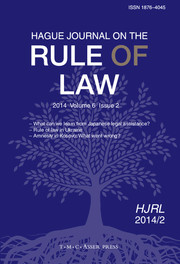No CrossRef data available.
Article contents
The Diffusion of American Judicial Independence Ideology into Taiwan and South Korea
Published online by Cambridge University Press: 10 October 2013
Abstract
Ideologies of judicial independence spread around the world and greatly affect court organisation and behaviour. How does this happen? Using the social science of the diffusion of innovations, this paper analyses how judicial independence doctrines spread to South Korea and Taiwan. The style of judicial independence that has mainly influenced Korea and Taiwan first developed in nineteenth-century Germany, from where it spread to Japan during the Meiji Reformation. It made judges bureaucratically accountable to a judiciary that was theoretically very independent from the executive branch, but left judges somewhat vulnerable to internal pressures. Korea and Taiwan received this theory and its related court organisational structures from Japan during colonisation and afterwards as they voluntarily updated their institutions to follow post-war Japanese changes. During years of authoritarian rule, these two countries' courts lost much of their independence. After democratisation, activists came to be disillusioned with the prevailing conception of judicial independence, and came under the influence of American ideas, under which judges would be selected to lifetime positions and not promoted bureaucratically. Agitating for reform, these activists attacked their judiciaries and advocated changes. The diffusion of the US vision of judicial independence ideology depended on the style of decision-making process, unity between judges and reformers outside the courts, and the difusion of ideas that occurred through the attainment of educations in America. Case studies of these similar countries can illustrate how notions of judicial independence are able to take root and develop in foreign nations seeking to modernise their court systems.
- Type
- Articles
- Information
- Copyright
- Copyright © T.M.C. Asser Press and the Authors 2013




